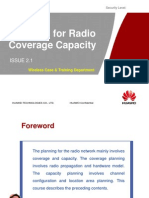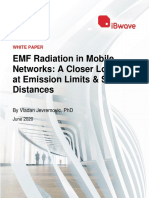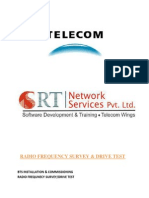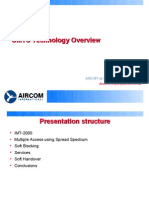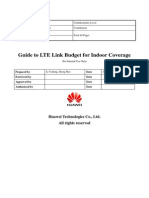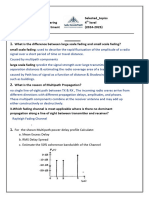1X3 Frequency Reuse Technology Guideline (v2.0)
1X3 Frequency Reuse Technology Guideline (v2.0)
Uploaded by
Rotimi OlajitanCopyright:
Available Formats
1X3 Frequency Reuse Technology Guideline (v2.0)
1X3 Frequency Reuse Technology Guideline (v2.0)
Uploaded by
Rotimi OlajitanCopyright
Available Formats
Share this document
Did you find this document useful?
Is this content inappropriate?
Copyright:
Available Formats
1X3 Frequency Reuse Technology Guideline (v2.0)
1X3 Frequency Reuse Technology Guideline (v2.0)
Uploaded by
Rotimi OlajitanCopyright:
Available Formats
1x3 Frequency Reuse Technology (V1.
0)
Public Use
Documentation Center of Radio Planning and Design Section, Huawei Technologies
Document No.
Product version
Confidentiality level
Product name: M900/M1800
24 pages in total
1X3 Frequency Reuse Technology Guideline
(Public Use)
Drafted by: Reviewed by: Reviewed by: Approved by:
Topic Research Study Group
Date: Date: Date: Date:
2002-10-22 yyyy/mm/dd yyyy/mm/dd yyyy/mm/dd
Huawei Technologies All Rights Reserved
2005-01-18
1x3 Frequency Reuse Technology (V1.0)
Public Use
Table of Contents
1 General..........................................................................................................................................................3 1.1 Application background...................................................................................................................4 1.2 Basic concepts..................................................................................................................................4 1.3 The advantages and disadvantages of 1*3.......................................................................................5 1.3.1 Advantages............................................................................................................................5 1.3.2 Disadvantages.........................................................................................................................5 2 1*3 tight reuse technology..........................................................................................................................6 2.1 Layout of sites .................................................................................................................................6 2.2 1*3 improve the capacity of network...............................................................................................7 2.3 1*3 tight reuse pattern......................................................................................................................8 2.3.1 The basic concepts of frequency hopping.............................................................................9 2.3.2 Continuous allocation mode..................................................................................................9 2.3.3 Interval allocation mode......................................................................................................10 2.3.4 The comparison of two allocation modes...........................................................................10 2.4 1*3 probability of ad-frequency collision .....................................................................................12 2.4.1 Distribution of ideal meshes...............................................................................................12 2.4.2 Irregular network.................................................................................................................13 2.5 1*3 reuse technique impact on network quality ...........................................................................15 2.5.1 Frequency hopping influence on speech quality................................................................15 2.5.2 Impact on 1*3 network performance caused by C/I...........................................................16 2.5.3 Impact on 1*3 caused by layout of sites.............................................................................16 2.5.4 Impact on 1*3 network performance caused by engineering parameters .........................17 2.5.5 Impact on 1*3 network capacity cause by handover..........................................................21 2.5.6 Impact on 1*3 network cause by load handover................................................................23 3 1*3 frequency-hopping data configuration...............................................................................................23
2005-01-18
1x3 Frequency Reuse Technology (V1.0)
Public Use
1X3 Frequency Reuse Technology Guideline
Key words: Frequency planning, 1*3, 4*3, tight reuse, base transceiver station layout,
ideal mesh, capacity
Abstract: This document combines radio network layout and application experience of 1*3
reuse. It is a guideline to introduce the principles and measures of 1*3 tight reuse frequency planning. Name Author Reference List Code Released date Where and how to access Publisher
1 General
2005-01-18
3
1x3 Frequency Reuse Technology (V1.0)
Public Use
Due to the shortage of frequency resource, in recent years equipment manufactories and operators have been focusing on improving the efficiency of frequency utilization in GSM system, and they try to improve network capability in limited frequency resource.
1.1 Application background
At the beginning of GSM network construction with small capacity, 4*3 reuse pattern or more loose frequency reuse technology are employed. With the increasing of network capacity, new tight reuse technologies appear, such as 3*3, MRP, 1*3, and 1*1. It is hard to decide when to use 1*3 tight reuse in actual network planning, because different operators have much different frequency resource. The maximal site configurations under different frequency bandwidth and reuse patterns are listed as follows: Table1 Frequency bandwidth --tight reuse technology--the maximal configuration Bandwidth 6 MHz 7 MHz 8 MHz 10MHz Notes: 1. Configurations listed above are theoretic values 2. Because the amount of carriers participated in frequency hopping is equal to frequencies used under the MRP reuse pattern, so for small configuration site, frequency hopping obtains small gains. Hereby, MRP is not suitable. 1*3 must adopt radio frequency hopping. The essence of tight reuse technology is bartering capability with quality. The tighter the frequency reuse is, the worse network quality will be. Therefore, it is better to adopt loose reuse frequency. BCCH carrier frequency must adopt 4*3 pattern in an actual frequency planning, BCCH needs at least 12 frequencies (because of the importance of BCCH, 14 frequencies are given to BCCH. So real maximal configuration is less than the value in the above table. For example, if 6MHz bandwidth adopts 1*3, theoretical maximal configuration can only reach S4/3/3). 1.2 Basic concepts In frequency planning, Frequency Reuse Factor is often used to scale frequency utilization efficiency or tightness degree of frequency reuse. Frequency Reuse Factor is defined as below: 4*3 S3/2/2 S3/3/2 S4/3/3 S4/4/4 MRP S4/4/4 S5/5/5 S6/6/6 1*3 S4/4/3 S5/4/4 S6/5/5 S8/8/8
2005-01-18
1x3 Frequency Reuse Technology (V1.0)
Public Use
K = N W /N TRx
K is Frequency Reuse Factor; NW is the number of available frequencies; NTRX is the maximal amount of carriers in a cell. When 15 frequencies are used for the carriers participating in frequency hopping and the number of FH carriers in the cell is 2, Frequency Reuse Factor K = 7.5. When the number of FH carriers is 3, K = 5.
Figure 1 The overlapped depth of coverage is different in cells Figure 1 The coverage overlap Because the different overlapped depth of A and B network, the number of As adjacent cells is less than Bs, so the interference of B is bigger than As. Conclusion: The more adjacent cells are, the bigger the probability of co-frequencies collision is, and the lower the utilization efficiency is. Therefore, the amount of adjacent cell should be decreased whichever frequency reuse technology is used.
1.3 The advantages and disadvantages of 1*3 1.3.1 Advantages
1. The 1*3 reuse pattern is tighter than 3*3 and MRP , so capability proportion that can be improved is higher than the latter. 2. The frequency planning is simple. Only BCCH frequency planning is necessary. During network optimazation and carrieres expansion, frequency planning neednt be made again. 3. The technology can improve planning efficiency greatly. 4. Radio frequency hopping is adopted, frequency hopping gain is higher than baseband frequency hopping(baseband frequency hopping cant be used for 1*3 reuse pattern).
1.3.2 Disadvantages
1. Broadband combiner is needed and cavity combiner with the property of frequencies
2005-01-18
1x3 Frequency Reuse Technology (V1.0)
Public Use
selection cant be used on 1*3. 2. Broadband repeater is adopted, because 1*3 has much influence on frequency-selected repeater. 3. As the reuse distance decreases, interference of ad-frequency and co-frequency will increase rapidly. 4. Network needs delicate optimizing adjustment. Especially, The overlap of coverage should be restricted strictly. It is worthy to point out that most sites configuration can only be S2/2/2 and few of them can be S3/2/2 while we adopt general 4*3 tight reuse technology and 6MHz band is available. Otherwise the network performance will be out of control. When 1*3 close reuse technology is used, the maximal configuration is S4/3/3(but it is a theoretical value, the actual configuration is S3/3/3 generally). Moreover, the capacity is twice of 3*4 reuse technology, which can save the invests of operators greatly (the expense of tower, equipment room, power supply, transmission and other assistant equipment will be higher than the BTS equipment).
2 1*3 tight reuse technology
As some anti-interference technologies cant be employed on BCCH carrier, such as frequency hopping, power control and DTX. Therefore BCCH frequency can only use 4*3 reuse pattern.1*3 tight reuse technology is general used on no-BCCH carriers. How to make a 1*3 frequency planning is illustrated by an actual planning within 6MHz band.
2.1 Layout of sites
Sites layout is an important work in the prophase of network planning. Whichever frequency planning technology is used, reasonable distribution of the sites is always concerned, which is based on the requests of coverage, capacity, network quality and construction invests. In the premise of meeting coverage and capacity, the urban sites should be distributed in the ideal meshes in order to absorb the traffic as possible. However due to the constraint of landform and tenancy, the actual sites cant be put on ideal meshes and they are always distributed irregularly. Comparatively, 4*3, 3*3 and MRP have a more tolerance on irregular layout of sites, while for 1*3, layout of sites should be as regular as possible. Therefore, we should decide the technology of Frequency planning according to usable frequency
2005-01-18
1x3 Frequency Reuse Technology (V1.0)
Public Use
resource, maximal site configuration which could meet the requisition of capability nowadays and in the future. What is ideal mesh? The relative position of ideal meshes must meet some mathematics relation, the relation of the equilateral triangle.
Figure 2 The allocation of ideal stations The experience proves that the quality of network and utilization efficiency of frequency will be best when the sites are based on ideal meshes. In other words, more users will be contained.
2.2 1*3 improve the capacity of network
1*3 tight reuse technology can improve the capacity greatly. Using general frequency reuse technology, the maximal configuration is S3/2/2 when bandwidth is 6MHz. Nevertheless, using 1*3 tight reuse technology the maximal configuration is S4/3/3 with the same bandwidth. The relation of configuration and capacity is listed below:(6MHz bandwidth, GOS=2%, 0.02 Earl /user) Table 2 The capacity increasing Reuse pattern 4*3 1*3 Configuration S2/2/2 S3/3/3 S4/3/3 Cell 1 capacity (Erl) 8.20 14.03 21.00 Cell 2 capacity (Erl) 8.20 14.03 14.03
7
Cell 3 capacity (Erl) 8.20 14.03 14.03
Site capacity (Erl) 24.60 42.09 49.06
The amount of subscribers 1230 2104 2453
2005-01-18
1x3 Frequency Reuse Technology (V1.0)
Public Use
Notes:The capacity is theoretical values, in actual planning 70~80 percents of theoretical capacity above is available.
Capacity increasement-compare with S222 Diagram3: The capability increase
120. 00% 100. 00% 80. 00% 60. 00% 40. 00% 20. 00% 0. 00%
Figure 3 The capacity increasement
S333 S433
Figure 3 The capacity increasing The capability will increase 99 percents after using 1*3 tight reuse technology under the condition the quality of network could be accepted.
2.3 1*3 tight reuse pattern
When using 1x3 frequency reuse pattern, three cells of every site will constitute a cluster. Reuse pattern of frequency will work in every cluster. In other words, the same cell of different sites will use the same frequency set. It will be shown in the figure below.
Figure 4 1*3 tight reuse pattern While adopting 1*3 tight reuse technology, we must use Radio Frequency Hopping. There are two kinds of allocation mode of MA: continuous allocation mode and interval allocation mode. Principles of frequency hopping are expressed as follows:
MAI = fMAIO, FN, MA, HSN, N = fFNHSNN fMA, MAIO
2005-01-18
1x3 Frequency Reuse Technology (V1.0)
Public Use
where MAI is mobile allocation index; N is the amount of frequency in MA; FN is frame number. When FN, HSN, N of the three cells in the same site are all the same, MAI is only related to MA and MAIO. It shows that ad-frequencies collision intra-site can be controlled by planning MA and MAIO carefully. It also shows that ad-frequencies collision inter-site will be controlled when the amount of the frequencies in MA of the three cells is the same. NOTICE: It is different from the FH descriptions in GSM Protocol that the cells of intra-site share the same HSN. The reason is to avoid inter-cell ad-frequencies collision in the site. It is determined by BTS equipment that FN of different cells in the same site is the same. When the number of sites with frequency hopping is more than 63, those sites that are far apart between them can reuse HSN.
2.3.1 The basic concepts of frequency hopping
MA: Mobile Allocation, (in other words, the set of frequency hopping) is referred to the hopping frequencies in a cell. MA of max 64 frequencies is supported in HUAWEI BSC. HSN: Hopping Sequence Number, value range: 0~63. When HSN=0, it is circular frequency hopping; when HSN=1~63, it is pseudo-random frequency hopping. MAIO: Mobile Allocation Index Offset, value range is 0~(N-1), N is the number of carriers participating in frequency hopping. FN: Frame Number, range: 0~(51*26*2048-1). It is decided by BTS.
2.3.2 Continuous allocation mode
The MA and MAIO planning under continuous allocation mode are listed below: Table 3 Continuous allocation mode CELL 1 CELL 2 CELL 3 MA0 96 101 106 MA1 97 102 107 MA2 98 103 108 MA3 99 104 109 MA4 100 105 110 MAIO 0, 2 0, 2 0, 2
In continuous allocation mode, the maximal configuration is S3/3/3 (BCCH carrier without frequency hopping + 2 TCH carriers with frequency hopping). For bigger site configuration, the ad-frequencies collision in a cell is unavoidable.
2005-01-18
1x3 Frequency Reuse Technology (V1.0)
Public Use
2.3.3 Interval allocation mode
Under interval allocation mode, planning of MA and MAIO is listed below: Table 4 Frequency hopping aggregation in interval allocation CELL 1 CELL 2 CELL 3 MA0 96 97 98 MA1 99 100 101 MA2 102 103 104 MA3 105 106 107 MA4 108 109 110 MAIO 0, 2, 4 1, 3 0, 2
In interval allocation, the maximal site configuration is S4/3/3, .For bigger site configuration, the ad-frequencies collision in a cell is unavoidable.
2.3.4 The comparison of two allocation modes
For those two frequency allocation modes, BCCH carriers of all cells must take 4*3 reuse pattern. It is proved that BCCH frequencies should be more than 14. TCH carriers with 1*3 tight reuse must adopt radio frequency hopping. If the site configuration is less than S3/3/3, both of the two allocation modes could avoid ad-frequency collision in the same site. Comparison of two allocation modes: 1. MAIO is different between interval allocation and continuous allocation. 2. MA is different between interval allocation and continuous allocation. 3. Whether interval or continuous allocation mode is adopted, the ad-frequency collision could be avoided among the three cells in the same site by reasonable planning. The difference is: 1) Probability of co-frequency collision in cells with the same number in adjacent BTS is same. There is still ad-frequency collision in continuous allocation mode, but there is no ad-frequency collision in interval allocation mode. 2) In interval allocation, ad-frequency collision will happen among different cells of adjacent BTS. In continuous allocation, ad-frequency collision will happen among frequencies which locate on two ends of hopping frequencies set (for example, in this example, 100 in Cell 1,101 and 105 in Cell 2,106 in Cell 3), but collision wont happen in other frequency 4. Some testing of existing network proves: in 1*3 tight reuse pattern, continuous allocation mode is better than interval allocation mode (idle BURST testing). But the final conclusion needs more testing. Till now interval and continuous allocation modes both work normally
2005-01-18
10
1x3 Frequency Reuse Technology (V1.0)
Public Use
online. 5. When bandwidth is 6MHz, the maximal BTS configuration that continuous allocation mode supports is S3/3/3(theoretical value) and that supported by interval allocation mode is S4/3/3.
96,97,98,99,100
Continuous al location
96,99 ,102,105,108
Interval allocation
96,97,98,99,100 106,107,108,109,110 101,102,103 ,104,105 98,101,104 ,107,110
96,99,102,105 ,108 97,100,103,106,109
96,97,98,99,100 106,107,108,109,110
101,102,103 ,104,105
96,99,102, 105,108 98,101,104,107,110
97, 100,103,106,109
96,97,98,99,100 106,107,108,109,110 101,102,103 ,104,105 98,101,104,107,110
96,99,102,105,108 97,100,103,106,109
106,107,108,109,110
101,102,103 ,104,105
98,101,104 ,107,110
97,100,103,106,109
Figure 5 1*3 Instance of two allocation mode Notice: In the above allocation, BCCH frequency 111 should be used as less as possible. Especially, it cant use in the third cell (the cell contained 110 in MA). When continuous and interval allocation mode are used in one actual network (idle BURST send testing), there is no difference in coverage. On the other hand, continuous allocation mode is better than interval allocation mode in receiving quality and their difference is listed below: 50
40 30 20 10 0
ua l_ ua l_ ua l_ ua l_ LE ua ua ua ID Q Q Q Q Q Q Q Q ua
cont i nuous al l ocat i on % i nt erval al l ocat i on %
2005-01-18
l_ 1
l_ 4
l_ 5
l_ 7
11
1x3 Frequency Reuse Technology (V1.0)
Public Use
Figure 6 1*3 quality difference of two allocation mode Figure 6 The receiving quality of two allocation modes
2.4 1*3 probability of ad-frequency collision
After using 1*3 tight reuse technology, the probability of co-frequency and ad-frequency collisions will be increased greatly. The collision probability and impact on network performance are related to the amount of adjacent cells.
2.4.1 Distribution of ideal meshes
The most perfect assumption: engineering parameters of sites are completely consistent. Propagation environment is identical too. Sites locate on ideal meshes. Load ratio of each cell is less than 40 percent. The number of the carriers participating in FH in a cell is 1 or 2, and the number of the frequencies participating in FH is 5. Cell Load Ratio is defined below: Cell Load Ratio = The number of carries participating in FH/ The number of frequencies participating in FH
Figure 7 1*3 tight reuse technology In this figure, there are no co-frequency collisions in cell A-3, but there are ad-frequency collision in A-3 with B-1, D-1, D-2 and C-2. In the figure, the number of ad-frequency collision cells is listed below: Table 5 The number of cells which there are ad-frequency collisions with A-2 Interference area Interference cells number X 2 X1 2 X2 1 X3 2 X4 1
Because it have been assumed that engineering parameters and propagation environment are all the same, the receiving levels of A-3 and adjacent cells are same at the receiving points. Because the interference at X, X1 and X3 is maximal, only calculating the probability at X is enough (The frequencies number in MA is 5):
2005-01-18
12
1x3 Frequency Reuse Technology (V1.0)
Public Use
1. When there is one carrier participating in FH in A-3, D-1, and D-2, the maximal probability of ad-frequency collision is:
P=
1 5
1 5
1 5
1 5
2 25
= 8%
2. When there are 2 carriers participating in FH in A-3, D-1, and D-2, the maximal probability of ad-frequency collision is :
P=
2 5
2 5
2 5
2 5
8 25
= 32%
3. When there are 2 carriers participating in FH in A-3, D-1, and D-2, the maximal probability of ad-frequency collision is :
P=
3 5
3 5
3 5
3 5
18 25
= 72%
Notes: when three carriers participate in FH and the frequency number in MA is 5, continuous allocation mode can't avoid ad-frequency collision intra-cell. But interval allocation mode can avoid ad-frequency collision intra-cell. When the site configuration is lower than S4/3/3, interval allocation mode can avoid ad-frequency collision between adjacent cells of the site. When the configuration is higher than S4/3/3, interval allocation cant avoid ad-frequency collision between adjacent cells of a site. The calculation proves that when MA is fixed, probability of ad-frequency collision has direct ratio with square of carriers participating in FH. In other words, ad-frequency interference will increase rapidly with increasing of network capability. It needs to be pointed out that the calculation above is done when network runs under full load. Actually the network load is lower than the full. One connection in A-3 cell will cause ad-frequency interference to connections, which locate on the same timeslots in D-1 and D2, and there is no ad-frequency interference to the other timeslots. Therefore, ad-frequency collision of actual network is related to the number of connections.
2.4.2 Irregular network
The analysis listed above is based on ideal regular network, but the adjacent-cells of one service cell are very complicated because of the difference of network structure and propagation environment. When overlap of coverage cant be controlled well, the adjacent cells with ad-frequency and co-frequency collision will appear. Assumption: 1) One cell has j adjacent cells in some interfered area and the receiving signal strength of different adjacent cells is same.
2005-01-18
13
1x3 Frequency Reuse Technology (V1.0)
Public Use
2) The cell has j-2 adjacent-cells of other BTS, including k adjacent cells have the same number with the current cell. 3) The number of frequencies participating in FH is N. 1. When there is one carrier participating in FH, The probability of co-frequency collision:
P = (1 n
1 n)
k = k/n 2
The probability of ad-frequency collision:
P = (1 n
1 n)
(j 2 k) = (j 2 k)/n 2
2. When there are two carriers participating in FH, The probability of co-frequency collision:
P = 4k/n 2
The probability of ad-frequency collision:
P = 4(j 2 k)/n 2
3, when there are m carriers taking part in frequency hopping The probability of co-frequency collision:
P = m 2 k/n 2
The probability of ad-frequency collision:
P = m 2 (j 2 k)/n 2
The probability of collision is related to connections in network. The key points to garanntee network performance: 1. The layout of the sites locations should be distributed along the regular meshe, and antennas height should be almost same during the planning and design period. 2. In optimizing period the coverage should be controlled right to aviod the co-frequnecy adjacent cells with the same number. According to calculation listed above, C/Ia should be 0 in X area, but the actual C/I is much lower than this value because of the coverage overlap, the fast fading and handover threshold. Therefore, the key works during optimization are to reduce the depth of overlap coverage and improve the handover sensitivity.
2005-01-18
14
1x3 Frequency Reuse Technology (V1.0)
Public Use
2.5 1*3 reuse technique impact on network quality 2.5.1 Frequency hopping influence on speech quality
According to subject evaluation of speech quality, FH has much impact on Rx Qual of MS. Testing result and subject evaluation is listed below: Table 6 Rx Qual difference between FH and without FH 0 A A 1 A A 2 B A Rx_Qual 3 4 B C B B 5 D C 6 D D 7 E E
Subject evaluation
Without FH FH
Table 7 Subject evaluation grade Subject evaluation grade A B C D E Evaluation criterion Very clear, no noise clear, a little noise Understood, noise Understood after repeating Cant be understood
Testing result proves: Receiving quality and subject speech quality in FH is different from that in without FH. When FH is not used, Rx_Qual is 0 or 1, subject speech quality is A; Rx_Qual is below 3, subject speech quality is clear. When FH is used, Rx_Qual is 0,1 and 2, subject speech quality is A; Rx_Qual is below 4, subject speech quality is clear; Rx_Qual is above 6, there are no difference between FH and without FH. Subject evaluation and quality grade between FH and without FH is showed below:
8 7 6 Rx_Qual 5 4 3 2 1 0 3 4 5 6 subject evaluation Figure 8 The difference of Subject evaluation and quality grade 0 1 2 A A B B C C Rx_Q ual no FH Rx_Q ual FH D E
2005-01-18
15
1x3 Frequency Reuse Technology (V1.0)
Public Use
Figure 8 Subject evaluation and Rx_Qulity 2.5.2 Impact on 1*3 network performance caused by C/I
The drive test data of idle BURST sending (at this time interference cell send out data continuously without power control) is analyzed in detail.
The relation of C/I and receiving quality grade from the driver testing data is shown as follows:
Table 8 C/I and Rx_Qual
Rx_Qual C/I (dB) 7 1 6 2 5 3 4 10
When C/I of 1*3 network is greater than 10dB, the subject speech quality can reach B (clear, a little noise). When C/ I is between 3~10dB, subject speech quality is C (understood, noise). When C/I is less than 3dB, network performance will deteriorate rapidly. Testing data proves that interference source in which quality grade is lower than 3 is caused by ad-frequency collision between different-numbered cells of adjacent sites.
2.5.3 Impact on 1*3 caused by layout of sites
When 1*3 tight reuse is employed in an actual network, the test result shows the conclusion that the network performance of regular sites distribution is better than that of irregular sites distribution.
100. 00 90. 00 80. 00 70. 00 60. 00 50. 00 40. 00 30. 00 20. 00 10. 00 0. 00
d G e0 ra d G e1 ra d G e2 ra d e G ra 3 d G e4 ra d G e5 ra d G e6 ra d e 7 G ra
16
regul ar cel l i rregul ar cel l
R ecei vi ng Q ual i t y
2005-01-18
1x3 Frequency Reuse Technology (V1.0)
Public Use
Figure 9 The comparison of receiving quality ratio between regular cells and irregular cells The data above is originated from an actual running network, and the conclusion can be made that the distribution of the sites is very important for 1*3 network.
2.5.4 Impact on 1*3 network performance caused by engineering parameters
Engineering parameters include site location, layout, antenna height, azimuth angle, downtilt and so on. Once site location and layout are decided and put in practice, they are difficult to change. Therefore site should locate on the ideal meshes as possible. And the azimuth angle and downtilt of antennas should be selected properly. When antenna is too high, the height should be decreased to avoid interference. The traffic statistic indexes will be compared between the 4*3 network, 1*3 network without engineering parameters optimization and 1*3 network with engineering parameters optimization. The comparison is listed as follows: Table 9 The comparison of traffic statistics indexes SDCCH call 4*3 1*3 without optimization 1*3 with optimization drop rate 0.25% 0.3% 0.22% SDCCH congestion rate 0% 0.3% 0.01% TCH call drop rate 0.92% 0.79% 0.66% TCH congestion rate 1.22% 1.19% 1.13% Traffic (Erl) 166.79 172.93 178.87 Handover success rate 93.02% 92.33% 93.45%
According to data above, after 4*3 reuse network is changed to 1*3 and before optimization, SDCCH congestion rate deteriorate greatly, handover success rate drop, SDCCH call drop rate and TCH congestion rate change little and traffic increase a little. After optimization 1*3 network, each index is improved. Compared with index before optimization, five key indexes (SDCCH congestion rate, SCCH call drop rate, TCH call drop rate, TCH congestion rate and handover success rate) have exceeded or reached indexes before optimization.
2005-01-18
17
1x3 Frequency Reuse Technology (V1.0)
Public Use
4*3 1. 40 1. 20 1. 00 % 0. 80 0. 60 0. 40 0. 20 0. 00
1*3 w t hout O mzat i on i pti i
1*3 w t h O i mzat i on i pt i
SD C cal l drop CH
SD C congesti on CH
TC cal l drop H
TC congest i on H
Figure 10 The traffic statistics indexes contrast 200. 00 180. 00 160. 00 140. 00 120. 00 % 100. 00 80. 00 60. 00 40. 00 20. 00 0. 00 Traf f i c H andover success 4*3 1*3 Wt hout O i mzat i on i pt i 1*3 Wt h O mzati on i pti i
Figure 11 The traffic statistics indexes contrast
2005-01-18
18
1x3 Frequency Reuse Technology (V1.0)
Public Use
Table 10 Other traffic statistics indexes contrast HO Traffic 4*3 1*3 before optimization 1*3 after optimization 166.79 172.93 178.87 Interf.B and 3 2.41 2.40 4.00 Interf. Band 4 0.15 0.28 0.40 Interf. Band 5 0.16 1.56 0.11 Requests of BQ 859 2433 1832 HO Requests 9985 12716 11895 Call set up 10362 11190 11935 Average HO times per connection 0.96 1.14 0.99
i nt erf . band3 4. 50 4. 00 3. 50 3. 00 2. 50 2. 00 1. 50 1. 00 0. 50 0. 00 4*3
i nt erf . band 4
i nt erf . band 5
1*3 bef ore opt i mzat i on i
1*3 af t er opt i mzat i on i
Figure 12 Other traffic statistics indexes contrast The number of idle channels falling into interference band 5 is much lower than that of before 1*3 optimization.
BQ handover s 14000 12000 10000 8000 6000 4000 2000 Handover r equest s Cal l set up
2005-01-18
0 4*3
1*3 bef or e opt i m zat i on i
19
1*3 af t er opt om zat i on i
1x3 Frequency Reuse Technology (V1.0)
Public Use
Figure 13 Other traffic statistics indexes contrast
2005-01-18
20
1x3 Frequency Reuse Technology (V1.0)
Traf f i c 14000. 00 12000. 00 10000. 00 8000. 00 6000. 00 4000. 00 2000. 00 0. 00 4*3 1*3 bef ore opt i mzat i on i 1*3 af t er opt i m zat i on i Cal l set up
Public Use
Figure 14 Other traffic statistics indexes contrast Comparing 1*3 FH network before optimization with 4*3 no FH network, handover times increased by about 2700 times and total Bad Quality handovers increased by about 1600 times. Comparing 1*3 FH network after optimization with 4*3 no FH network, handover times increased by about 1900 times and Bad Quality handovers increased by about 1000 times. Compare increase of Call set up times with increase of traffic, the conclusion can be made that traffic increasing is natural. The increase of handover times makes little contribution on traffic increasing, and it will be explained in next section. The increasing proportion of total bad quality handovers is much higher than that of traffic. On one hand, it is due to the closer reuse frequency and the irregularity of real experimental network causes interference in some area; on the other hand, interference handover threshold (50) in 4*3 reuse is equal to 1*3 tight reuse threshold. The subject speech quality of frequency hopping whose Rx_Qual is equal to 5 is as good as that of no frequency hopping network whose Rx_Qual is equal to 4(explained in 2.5.1 impact on network quality caused by frequency hopping). The difference of subject voice-quality standard is the main cause of the increase of bad quality handovers.
2.5.5 Impact on 1*3 network capacity cause by handover
When MS handover from a cell to another cell in the same BSC, TCH channel of the old cell won't be released after the target cell TCH channel is activated, until BSC receives HO Complete message from the new cell. During Channel Activation and RF Chan Release Ack, TCHs of the old and new cell are occupied by the same connection. In this period, traffic statistics will repeat to count TCH seizure time. The contribution on traffic caused by handover will be analyzed. In order to prove whether handover will increase traffic, The test of synchronous and
2005-01-18
21
1x3 Frequency Reuse Technology (V1.0)
Public Use
asynchronous handover have been made on GSM1800 network that havent been in use commercially. Signaling time from the new cell's CHANNEL ACTIVATION (caused by handover) to the old cell's RF CHAN RELEASE ACK is gotten by testing. Synchronous handover counts 20 times and asynchronous handover counts 11 times. The result is listed below: Table 11 The time of two channels are occupied by one connection during HO (1800M) Average time(ms) Synchronous handover Asynchronous handover times are 18. Table 12 The time of two channels are occupied by one connection during HO (900M) Handover time Testing of traffic statistics is done in laboratory. Statistic period is 15 minutes and MS handover between cell A to cell B. During testing period, there are no other subscribers using the two cells and another MS seizures cell C all the time as the terminated. Testing results are listed below: Table 13 Lab tests Cell A Cell B Add up Cell C Statistic time(min) 15 15 15 15 Handover times 9 9 18 0 Statistic traffic(Erl) 0.1400 0.1125 0.2525 0.2500 Average time(ms) 745 Shortest time (ms) 584 Longest time(ms) 1675 348 408 Shortest time(ms) 339 398 Longest time(ms) 420 450
The test of handover period is done in GSM900 network with large traffic, and handover
Only one subscriber occupied the channel in cell A or B during 15 minutes testing period, If no handover occurs, the traffic should be same between them. But the total traffic of Cell A and B is 0.2525Erl, and the traffic of cell C is 0.25Erl. The excessive 0.0025Erl traffic is due to handover, and the average crossed-time every handover is 0.5 seconds. Notice: because the shortest interval of traffic statistics is 480 ms, handover crossed-time calculated by traffic statistics has a certain error. Comparing network with large traffic and low traffic, handover crossed time increases greatly while traffic become high. It is assumed average handover crossed-time is 0.78s, and the increasing traffic is 2Erl every 10000 handover (0.75*10000/3600).
2005-01-18
22
1x3 Frequency Reuse Technology (V1.0)
Public Use
Comparing the handover increase of 1*3 network before optimization with that after optimization, suppositional added traffic is about 0.4Erl caused by 2000 handovers. So 12Erl traffic increasing is natural. Conclusion: Suppositional added traffic is about 2Erl when 10000 handovers are made. Impact on traffic caused by suppositional added traffic should be considered when handover times are extremely high. On the other hand, data above proves that handover speed is related to traffic (the more traffic, the longer handover time).
2.5.6 Impact on 1*3 network cause by load handover
Table 14 Traffic statistics indexes contrast between enable and disable load handover Load handover Enable Disable Date 16 th, 1 17 th, 1 18 th, 1 23 rd, 1 24 th, 1 25 th, 1 Traffic Erl 182.98 166.39 171.9 180.35 181.8 174.47 TCH call drop rate % 1.01 0.89 0.93 0.54 0.55 0.43 TCH Congestion rate % 0.8 0.44 0.45 0.4 0.28 0.49 Handover success rate % 95.59 96.29 96.13 96.09 / 96.71 Handover failure rate 567 412 427 467 / 385
Comparing traffic statistics indexes between enabling and disabling load handover, TCH congestion rate is not high, but it hasnt been lowered greatly after enabling load handover and call drop rate increases distinctly. Conclusion: Load handover cant be employed in 1*3 network. For example the bandwidth of load handover is 25dB and the connections meet the load HO conditions, they will handover to second best cell and seize FH channels with serious interference, and call drop rate will increase distinctly. In order to ensure that MS camp in cells with strongest signal, cell selection and reselection parameters should be consistent with each other in 1*3 network.
3 1*3 frequency-hopping data configuration
1*3 configuration data related to frequency hopping is same with other frequency hopping. Table is shown as bellows:
2005-01-18
23
1x3 Frequency Reuse Technology (V1.0)
Public Use
Table 15 1*3 data configuration related to frequency hopping Menu name Table name Parameter FH index No. Radio Channel Configuration Table MAIO Local office FH index No. Frequency Hopping Data Table TSC ARFCN 1~ ARFCN N ARFCN 1~ Carrier Site Configuration Table Cell Configuration Cell Data Table Cell Allocation Table FH mode ARFCN 1~ ARFCN N ARFCN N Static TRX Power class HSN 0~1023 0~N-1 Value 0~1023 Annotation Index to frequency- hopping data table. And the value of the FH TRX carriers in a cell should be same. Mobile Allocation Index Offset. In this case, the same MAIO is recommended for all channels of a TRX and different MAIO for different TRX in the same cell. Correspond to item in Radio channel configuration table Hopping Sequence Number. HSN in different cells of the same site is the same Training Serial Code, Same with BCC. Frequencies in MA participating in FH BCCH frequency and frequencies in MA participating in FH Power class "0" shows that power is in its maximum. Each class is 2dB less than its former class. FH mode should be RF FH for 1*3 frequency reuse pattern BCCH frequency and frequencies in MA participating in FH
1~63
0~7 Available frequency Available frequency 0~10, unit:2dB Radio frequency hopping Available frequency
2005-01-18
24
You might also like
- ATN 910 910I 910B 950B V200R003C00 Configuration Guide 02 CLI PDFDocument4,459 pagesATN 910 910I 910B 950B V200R003C00 Configuration Guide 02 CLI PDFwerazocastro50% (4)
- Indoor Radio Planning: A Practical Guide for 2G, 3G and 4GFrom EverandIndoor Radio Planning: A Practical Guide for 2G, 3G and 4GRating: 5 out of 5 stars5/5 (1)
- Passive DAS Vs Active DAS Vs Hybrid DAS ComparisonDocument2 pagesPassive DAS Vs Active DAS Vs Hybrid DAS ComparisonAbhay SharmaNo ratings yet
- Railway Operational Communication Solution GTSOFTX3000V200R001C01 Product Description V1.0 (20130311)Document89 pagesRailway Operational Communication Solution GTSOFTX3000V200R001C01 Product Description V1.0 (20130311)Leonardo MorallosNo ratings yet
- Radio Spectrum Management: Policies, Regulations and TechniquesFrom EverandRadio Spectrum Management: Policies, Regulations and TechniquesNo ratings yet
- Base Station Equipment and Radio-Frequency Signal FlowDocument5 pagesBase Station Equipment and Radio-Frequency Signal FlowSaibal RayNo ratings yet
- Diversity AntennaDocument12 pagesDiversity AntennaLee NghiaNo ratings yet
- G-LII 202 Planning For Radio Coverage Capacity-20080312-A-2.1Document26 pagesG-LII 202 Planning For Radio Coverage Capacity-20080312-A-2.1naveedalishaNo ratings yet
- Frequency Assignment and Interference AnalysisDocument60 pagesFrequency Assignment and Interference AnalysisMahmood AdelNo ratings yet
- Link BudgetDocument15 pagesLink BudgetJayant VaishyaNo ratings yet
- UMTS Link Budget Basic ParameterDocument7 pagesUMTS Link Budget Basic ParameterexcaliburslvNo ratings yet
- EMF Radiation in Mobile Wireless Networks pt1Document19 pagesEMF Radiation in Mobile Wireless Networks pt1Camilo Andres Suarez RNo ratings yet
- CommScope - In-Building Wireless Solutions PDFDocument19 pagesCommScope - In-Building Wireless Solutions PDFculeros1No ratings yet
- EXFO Reference-Guide DAS-1 enDocument104 pagesEXFO Reference-Guide DAS-1 enmorrisking38No ratings yet
- 02) Radio Signal PropagationDocument40 pages02) Radio Signal PropagationAhmadHashemiNo ratings yet
- DMR Mobile Radio - Back To Back Application Notes - R2.0 I PDFDocument27 pagesDMR Mobile Radio - Back To Back Application Notes - R2.0 I PDFjasjusrNo ratings yet
- Passive Intermodulation Effects in Base Stations Understanding The Challenges and SolutionsDocument5 pagesPassive Intermodulation Effects in Base Stations Understanding The Challenges and SolutionsSatadal GuptaNo ratings yet
- 06-Indoor Planning ProcessDocument13 pages06-Indoor Planning ProcessyusufshabanNo ratings yet
- Wi Fi 6 - White PaperDocument21 pagesWi Fi 6 - White PaperĐinh Nhất LinhNo ratings yet
- A Client-Side Design and Implemenation For Push To Talk Over Cellular ServiceDocument19 pagesA Client-Side Design and Implemenation For Push To Talk Over Cellular ServiceAleksandar SharkovskiNo ratings yet
- 3 IBS Survey and DesignDocument55 pages3 IBS Survey and DesignAkhtar KhanNo ratings yet
- Planning For Radio Coverage & Capacity 2.0Document18 pagesPlanning For Radio Coverage & Capacity 2.0Santosh GuptaNo ratings yet
- Wcdma Radio Interface Physical LayerDocument53 pagesWcdma Radio Interface Physical LayerGiftNo ratings yet
- Andrew Smart Beam AntennaDocument12 pagesAndrew Smart Beam AntennaZeeshan SiddiqueNo ratings yet
- Analogue To DigitalDocument9 pagesAnalogue To DigitalStephany JaraNo ratings yet
- LTE RAN Planning CourseDocument2 pagesLTE RAN Planning CoursetetraprimigNo ratings yet
- Hytera DMR Systems and Solutions: Digital Mobile Radio Solutions For Professional UsersDocument4 pagesHytera DMR Systems and Solutions: Digital Mobile Radio Solutions For Professional Userscrispix2000No ratings yet
- iDEN BasicsDocument70 pagesiDEN Basicsottoniel camposNo ratings yet
- Long Term Evolution LTE Radio Access NetDocument192 pagesLong Term Evolution LTE Radio Access NetMaoly BustamanteNo ratings yet
- Communication Link AnalysisDocument11 pagesCommunication Link Analysiskiemthan_vdnNo ratings yet
- Bts Installation & Commissioning Radio Frequnecy Survey/Drive TestDocument7 pagesBts Installation & Commissioning Radio Frequnecy Survey/Drive TestAshok KumarNo ratings yet
- UMTS AircomDocument20 pagesUMTS AircomDũng PhạmNo ratings yet
- AIR Interface Info of GSMDocument45 pagesAIR Interface Info of GSMrajaNo ratings yet
- WCDMA PrinciplesDocument41 pagesWCDMA PrinciplesmoussouniNo ratings yet
- LS Brochure Spectrum Management System Solutions For Radio Spectrum Management and Network Planning and EngineeringDocument16 pagesLS Brochure Spectrum Management System Solutions For Radio Spectrum Management and Network Planning and EngineeringLuqman HadiNo ratings yet
- Using R&S Signal, Spectrum With MATLABDocument10 pagesUsing R&S Signal, Spectrum With MATLABStarLink1No ratings yet
- WCDMA PrincipleDocument98 pagesWCDMA PrincipleismailttlNo ratings yet
- Design and Test Technologies of A RepeaterDocument24 pagesDesign and Test Technologies of A Repeaternarges5058100% (1)
- Tait - DMR - Sales - Presentation - 18 May 2015Document77 pagesTait - DMR - Sales - Presentation - 18 May 2015JonesIvanSimamora100% (1)
- Atoll 2.8.3 RF Technical Reference Guide E2Document690 pagesAtoll 2.8.3 RF Technical Reference Guide E2post2pangaNo ratings yet
- Kenwood NEXEDGE Digital LMR System OvrviewDocument59 pagesKenwood NEXEDGE Digital LMR System OvrviewSparky01100% (7)
- SMART DAS Solutions Ver01Document79 pagesSMART DAS Solutions Ver01Anup Kumar40% (5)
- Capacity Case Study - ShortenedDocument11 pagesCapacity Case Study - Shortenedcyo3fff100% (1)
- RF Planning BasicsDocument14 pagesRF Planning BasicsRakesh SolankiNo ratings yet
- What Is LTE?: 3G WCDMA (R99) 3.5G HSPA LTEDocument20 pagesWhat Is LTE?: 3G WCDMA (R99) 3.5G HSPA LTEWaad AlteeNo ratings yet
- GSM TutorialDocument11 pagesGSM TutorialAnas RazzaqNo ratings yet
- DAS Signal Distribution Types Passive DASDocument4 pagesDAS Signal Distribution Types Passive DASnaeemansNo ratings yet
- Neutral Host DAS White Paper WP 108555Document6 pagesNeutral Host DAS White Paper WP 108555Pedro PrietoNo ratings yet
- GSM Phy Part-2Document13 pagesGSM Phy Part-2jitendra_engNo ratings yet
- Application Scenarios: HTZ Warfare Supports The Following FunctionsDocument2 pagesApplication Scenarios: HTZ Warfare Supports The Following FunctionsKENMOGNE TAMO MARTIALNo ratings yet
- Training On Microwave Communcation: by Nilesh PatelDocument39 pagesTraining On Microwave Communcation: by Nilesh PatelKo AungNo ratings yet
- IBS Intergration Service V100R002 Technical Guide LTE Link Budget 01-ZHDocument48 pagesIBS Intergration Service V100R002 Technical Guide LTE Link Budget 01-ZHOgg SilverlemoneNo ratings yet
- IBwave Certification Course SyllabusDocument3 pagesIBwave Certification Course SyllabusSandroTrigoValdiviaNo ratings yet
- C04-Wireless Telecom SystemsDocument55 pagesC04-Wireless Telecom SystemsVishnuPriyaNo ratings yet
- Ibs Distributed AntennasDocument19 pagesIbs Distributed AntennasMazenRedaNo ratings yet
- VoIP and Unified Communications: Internet Telephony and the Future Voice NetworkFrom EverandVoIP and Unified Communications: Internet Telephony and the Future Voice NetworkNo ratings yet
- Overview Product SolarwindsDocument3 pagesOverview Product SolarwindsZulkifli DjewedNo ratings yet
- Grade-7 Unit#3 All Q.ADocument4 pagesGrade-7 Unit#3 All Q.Aaimalramzan.5122No ratings yet
- 2022 IoT Wireless 5G EMC GuideDocument27 pages2022 IoT Wireless 5G EMC GuidewulanluvspinkNo ratings yet
- TC1284en-Ed135 OXO Connect Public SIP Trunking Interoperability and Technical SupportProcedureDocument51 pagesTC1284en-Ed135 OXO Connect Public SIP Trunking Interoperability and Technical SupportProcedurePablo MarmolNo ratings yet
- 31 Days To CCNA PDFDocument264 pages31 Days To CCNA PDFBo BiNo ratings yet
- CALLOWDocument2 pagesCALLOWLaramy ErnstbergerNo ratings yet
- Company Profile - KnsDocument11 pagesCompany Profile - KnsKrishna KnsNo ratings yet
- Crystal Radio Project (For ISC)Document5 pagesCrystal Radio Project (For ISC)Nabhoneel Majumdar100% (1)
- Lesson 5 Network Connector Types1Document29 pagesLesson 5 Network Connector Types1kayeleenpinedaNo ratings yet
- Bahria University, Islamabad Campus Quiz 1Document19 pagesBahria University, Islamabad Campus Quiz 1atif mehmoodNo ratings yet
- Forensic Analysis of Email 24112015 Meeting With OCH v1 - 1Document5 pagesForensic Analysis of Email 24112015 Meeting With OCH v1 - 1GarethvanZylNo ratings yet
- Chapter10 (Error Detection and Correction)Document48 pagesChapter10 (Error Detection and Correction)Rahil HussainNo ratings yet
- Acronyms A4 DuplexDocument178 pagesAcronyms A4 DuplexYahya MohammadNo ratings yet
- MFHF Radio Equipment.Document171 pagesMFHF Radio Equipment.Богдан КендзерNo ratings yet
- Log LogDocument2 pagesLog LogSigismund BeriaNo ratings yet
- Fortinet Enterprise Firewall Lab Guide For Fortios 72Document158 pagesFortinet Enterprise Firewall Lab Guide For Fortios 72Baba BoboNo ratings yet
- Labccna15 PDFDocument5 pagesLabccna15 PDFmayudesk deskNo ratings yet
- 2022 - Akshita - Flying Through The Secure Fog A Complete Study On UAV Fog in Heterogeneous NetworksDocument41 pages2022 - Akshita - Flying Through The Secure Fog A Complete Study On UAV Fog in Heterogeneous Networkssachin.eceNo ratings yet
- Midterm Problem SetDocument3 pagesMidterm Problem SetVia Marie MesaNo ratings yet
- SEL-2488 Satellite-Synchronized Network Clock: Advanced Time SynchronizationDocument8 pagesSEL-2488 Satellite-Synchronized Network Clock: Advanced Time SynchronizationTrung Trực Nguyễn PhạmNo ratings yet
- Sheet 1 - Selected - TopicsDocument5 pagesSheet 1 - Selected - Topicsaromo.newNo ratings yet
- VT 300 PDFDocument87 pagesVT 300 PDFanhdv1979No ratings yet
- Ale Omnipcx Enterprise Purple Ebook en PDFDocument12 pagesAle Omnipcx Enterprise Purple Ebook en PDFtee45No ratings yet
- Hadoop SCORE Checklist Ver0.2Document13 pagesHadoop SCORE Checklist Ver0.2icecapc2548No ratings yet
- Networking: Port ForwardingDocument6 pagesNetworking: Port ForwardingjamesmhebertNo ratings yet
- ISUP TimersDocument10 pagesISUP Timerskazi9tamjid9aliNo ratings yet
- 20240315-063046729 Debugtrace 744c.a1cf.3a9fDocument202 pages20240315-063046729 Debugtrace 744c.a1cf.3a9fKNo ratings yet
- Juniper CosDocument2 pagesJuniper CosSiva TejaNo ratings yet







